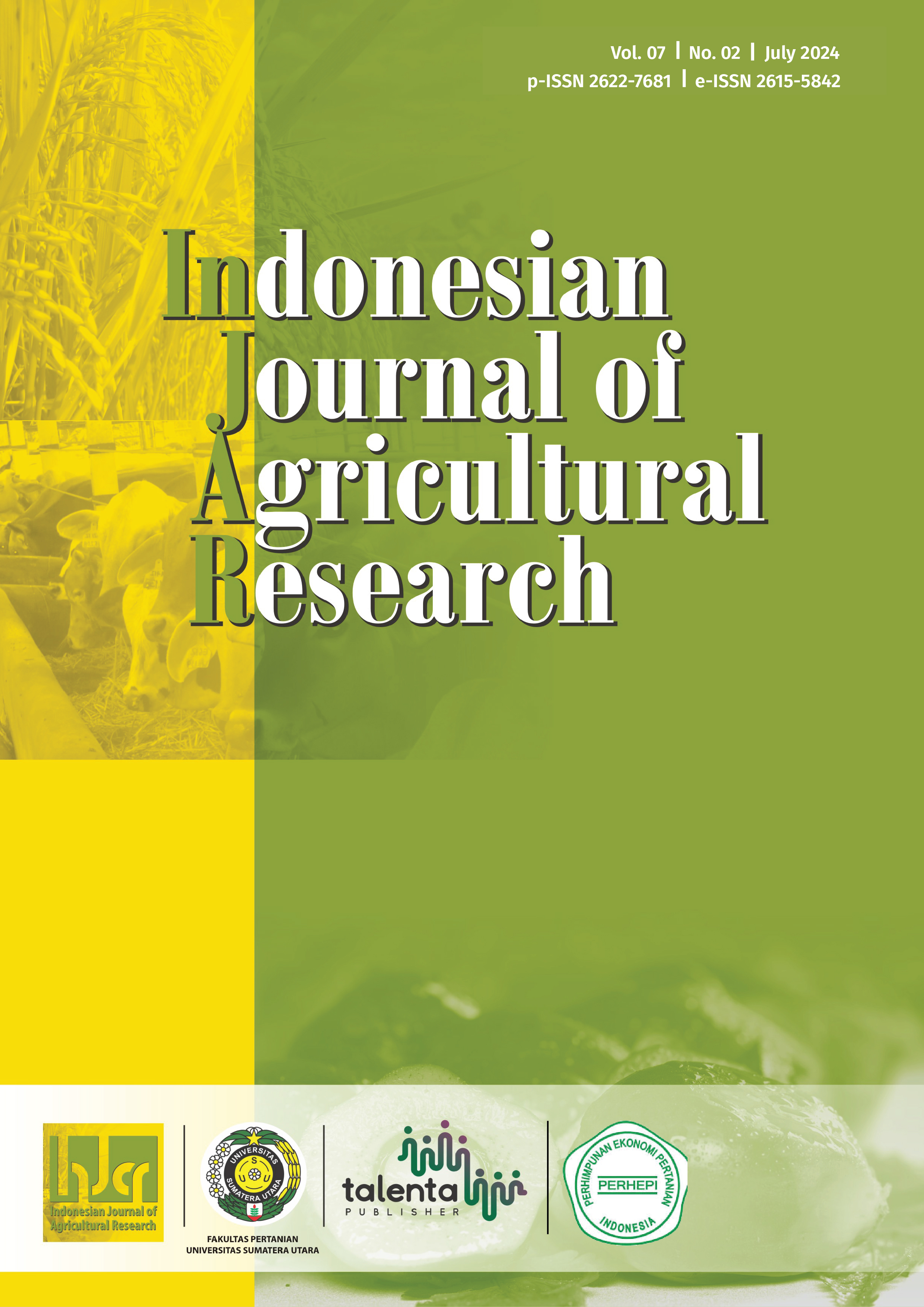The Role of Social Capital in the Development of Native Chicken Enterprises: A Case Study at P4S Laskar Andalas
DOI:
https://doi.org/10.32734/injar.v7i2.15893Keywords:
local economy, native chicken, social capitalAbstract
This study investigates the increase in native chicken population in Koto Parik Gadang Diateh District of South Solok Regency, credited to the transformation of MFH Farm into Pusat Pelatihan Pertanian dan Pedesaan Swadaya (P4S) Laskar Andalas. The objectives of this study include describing P4S Laskar Andalas' profile and role in native chicken business development and analyzing social capital's impact on the local economy through chicken farming. Using a case study approach, key informants such as P4S Laskar Andalas, KUB PM Koto Parik, native chicken breeders, and local restaurants were engaged. Findings reveal P4S Laskar Andalas' diverse role in native chicken husbandry, including enterprise operation, advisory services, and business partnerships. Strong social bonds between P4S Laskar Andalas, KUB-PM Koto Parik, and breeders indicate robust bonding social capital. Additionally, positive relationships with Sungai Kalu Restaurant and Teras Ayam Kampung Restaurant reflect well on bridging social capital. The strong association between P4S Laskar Andalas and the Agriculture Office of South Solok Regency demonstrates strong linkage social capital. These results underscore social capital's role in facilitating collaborative efforts and enhancing the local economy through native chicken farming.
Downloads
References
BPS-South Solok Regency, "South Solok Regency in 2022 Figures " BPS-South Solok Regency, 2023.
J. Pretty and H. Ward, " Social capital and the environment," World Development, vol. 29, no. 2, pp. 209 - 227, 2001.
N. Uphoff, "Understanding social capital: Learning from the analysis and experience of participation," in Social capital: A multifaceted perspective, P. Dasgupta and I. Serageldin Eds.: World Bank Publications, 1999, pp. 215 - 249.
R. D. Putnam, Bowling alone: The collapse and revival of American community. Simon and Schuster, 2000.
M. Woolcock and D. Narayan, "Social capital: Implications for development theory, research, and policy," The world bank research observer, vol. 15, no. 2, pp. 225-249, 2000.
T. Petersen, "The social capital of Danish dairy farmers," Journal of Socio-Economics, vol. 30, no. 2, pp. 85 - 100, 2001.
C. Grootaert and T. Van Bastelaer, Understanding and measuring social capital: A synthesis of findings and recommendations from the social capital initiative. World Bank Publications, 2002.
L. D. Lang, A. K. Tiwari, H. N. Hieu, N. M. Ha, and J. Gaur, "The role of structural social capital in driving social-oriented sustainable agricultural entrepreneurship," Energy Economics, vol. 124, p. 106855, 2023, doi: https://doi.org/10.1016/j.eneco.2023.106855.
R. Barghusen, C. Sattler, R. Berner, and B. Matzdorf, "More than spatial coordination–How Dutch agricultural collectives foster social capital for effective governance of agri-environmental measuresMore than spatial coordination – How Dutch agricultural collectives foster social capital for effective governance of agri-environmental measures," Journal of Rural Studies, vol. 96, pp. 246-258, 2022, doi: https://doi.org/10.1016/j.jrurstud.2022.10.023.
B. D. Zeleke, A. K. Geleto, S. Asefa, and H. H. Komicha, "The role of social capital in addressing seed access constraints and adoption intensity: Evidence from Arsi Highland, Oromia Region, Ethiopia," Heliyon, vol. 9, no. 2, 2023, doi: https://doi.org/10.1016/j.heliyon.2023.e13553.
T. Slijper, J. Urquhart, P. M. Poortvliet, B. Soriano, and M. P. M. Meuwissen, "Exploring how social capital and learning are related to the resilience of Dutch arable farmers," Agricultural Systems, vol. 198, p. 103385, 2022/04/01/ 2022, doi: https://doi.org/10.1016/j.agsy.2022.103385.
N. Zugravu-Soilita, R. Kafrouni, S. Bouard, and L. Apithy, "Do cultural capital and social capital matter for economic performance? An empirical investigation of tribal agriculture in New Caledonia," Ecological Economics, vol. 182, p. 106933, 2021/04/01/ 2021, doi: https://doi.org/10.1016/j.ecolecon.2020.106933.
E. Tuna and K. Karantininis, "Agricultural cooperatives as social capital hubs – A case in a post-socialist country," Journal of Co-operative Organization and Management, vol. 9, no. 1, p. 100134, 2021/06/01/ 2021, doi: https://doi.org/10.1016/j.jcom.2021.100134.
Y. Zhang and W. Zhao, "Social capital's role in mitigating economic vulnerability: Understanding the impact of income disparities on farmers' livelihoods," World Development, vol. 177, p. 106515, 2024/05/01/ 2024, doi: https://doi.org/10.1016/j.worlddev.2023.106515.
Downloads
Published
How to Cite
Issue
Section
License
Copyright (c) 2024 Indonesian Journal of Agricultural Research

This work is licensed under a Creative Commons Attribution-NonCommercial-ShareAlike 4.0 International License.



















